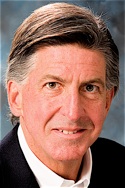This is an article I wrote early in the 21st Century <grin> about Santa Monica’s leadership in environmentalism and sustainability. It appeared in the June 2003 edition of THE SOUTHERN SIERRAN, the official Los Angeles and Orange County newspaper of the Sierra Club.
Santa Monica
Councilmember Kevin McKeown

As you walk along Santa Monica’s beachside clifftops, you might not realize the colorful 130-foot Ferris wheel sparkling below is the world’s first to run on solar power. On sunny days, 650 photovoltaic panels keep the wheel spinning, and visitors smiling, without a single volt of fossil fuel electricity.
That attractive, artsy building next to the Pier? Santa Monica’s pioneering urban runoff recycling facility gurgles happily as it catches the number one source of pollution affecting Santa Monica Bay.
This facility converts an average 500,000 gallons a day of runoff into “gray water,” which is then used throughout Santa Monica for irrigation. In the new Civic Center, buildings will be “double-piped” so the reclaimed water can be used to flush, saving fresh potable water.
THINKING AHEAD
Proactive stewardship of our Los Angeles County ecosystem has been official Santa Monica policy since the mid 90s, when we developed our first Sustainable City Program. The successes so far are evident everywhere.
When the lights come on at City Hall or any other municipal facility, not only do efficient fixtures conserve, but also the electricity itself is 100 percent from renewable resources. That cute green downtown hotel-and-shops shuttle is zero-emission electric, and the fabled Big Blue Bus transit fleet is fast moving to clean-burning compressed natural gas.
Residents have pitched in as well. Santa Monica offers commingled recycling, so households needn’t separate glass, paper and cans. The new single-bin system was an instant hit, with residential recycling up 11 percent.
The work over the last decade has made Santa Monica an acknowledged international leader and role model for municipal sustainability. Even after meeting or exceeding many of our initial targets, though, we realize our efforts are incomplete. Many challenges remain before Santa Monica truly can call itself a sustainable city.
At the beginning of a new century, how can we get cleaner and greener? What if we evaluated all our policies and actions in terms of the true cost to our planet instead of short-term economic expediencies?
GOING FURTHER
Beginning in 2001, a large team of community stakeholders including elected and appointed officials, city staff, and representatives of neighborhood organizations, schools, the business community and other community groups examined Santa Monica’s long-term sustainability with this expanded perspective. Updated goals and indictors were developed by Santa Monica’s longstanding Task Force on the Environment, and the new Plan enjoyed unanimous embrace at the city council.
For the first time, we included long-term sustainability factors such as mixed-use urban planning choices to encourage multi-modal transportation and reduce our car dependency.
We’ve set goals for more parks and for more unpaved, rainfall-permeable open space, and we’ve focused not just on human usage of our city but on natural land functions like streams and wildlife habitats.
Distant jobs without transportation options perpetuate our Southern California “commute and pollute” lifestyle, so the new Sustainable City Plan includes housing clustered around mass transit nodes. We’ve made a head start already on our Green Building Guidelines with an affordable housing project, walkably located downtown, that generates its own electricity from attractive glass-panel photovoltaics on the sunny sides of the building.
What about the sadly unwise natural resource impacts enthusiastically encouraged by our corporate consumer society? For the first time, Santa Monica’s “ecological footprint” will become a factor when our city and our residents consider consumption.
The ecological footprint is a measure of how one’s use of Earth’s resources measures against the portion of the planet to which one is justly entitled. An article on the concept, including a quick quiz to measure your personal ecological footprint, appeared in the January/February 2003 edition of “Sierra” magazine.
Santa Monicans will begin to take greater personal responsibility for how our consumption choices affect our community’s ecological footprint, even though the specific impacts and resource wastage engendered by our habits may occur outside the city.
DIET COUNTS TOO
Eating high on the food chain is generally accepted to be the average Americans’ second highest impact on the planet, after transportation. We must educate, not mandate, but one of the new plan’s desired outcomes will be an annual increase in the percentage of Santa Monica residents who report that vegetable-based protein dominates their diet.
Santa Monica has set itself a challenge: avoiding future environmental impacts by modifying over time the unsustainable activities of residents, businesses, institutions and visitors. Years of work lay ahead of us, but Santa Monica is well on the way to creating the basis for a more sustainable way of life – one that safeguards and enhances our resources, prevents harm to the natural environment and human health, and supports and benefits the community and local economy – for current and future generations.
Return to Environment page
Return to Welcome page




CITY AHEAD OF ITS TIME
Santa Monica’s Sustainable City Plan sets the model for urban centers that consider their effect on the planet
by Kevin McKeown
Remedial environmentalism is so Twentieth Century!
One high-profile Los Angeles County beach city has committed itself to avoiding environmental damage, not just cleaning up after it.